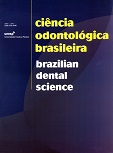Estudo radiográfico da localização da anti-língula em mandíbulas secas e sua relação com o forame da mandíbula
DOI:
https://doi.org/10.14295/bds.2004.v7i4.436Abstract
Os procedimentos cirúrgicos que envolvem o ramo da mandíbula utilizam um importante ponto de reparo ósseo na face lateral do ramo denominado de anti-língula (AL). A sua localização é importante, pois pode ser utilizada como um guia nas cirurgias, deste modo evitando danos ao feixe vásculo-nervoso que penetra no forame da mandíbula (FM). O objetivo neste estudo é identificar a presença da AL e sua relação com o FM. A amostra constou de 200 mandíbulas secas, às quais, foram radiografadas pelo método periapical convencional, posteriormente, digitalizadas e mensuradas. Os resultados foram expressos em percentagem e mostraram-se altamente variáveis, com a predominância da posição ântero-superior em relação ao FM. Foi avaliado também as distâncias máxima e mínima entre os dois pontos anatômicos referidos.Downloads
Downloads
Published
How to Cite
Issue
Section
License
Brazilian Dental Science uses the Creative Commons (CC-BY 4.0) license, thus preserving the integrity of articles in an open access environment. The journal allows the author to retain publishing rights without restrictions.
=================




























